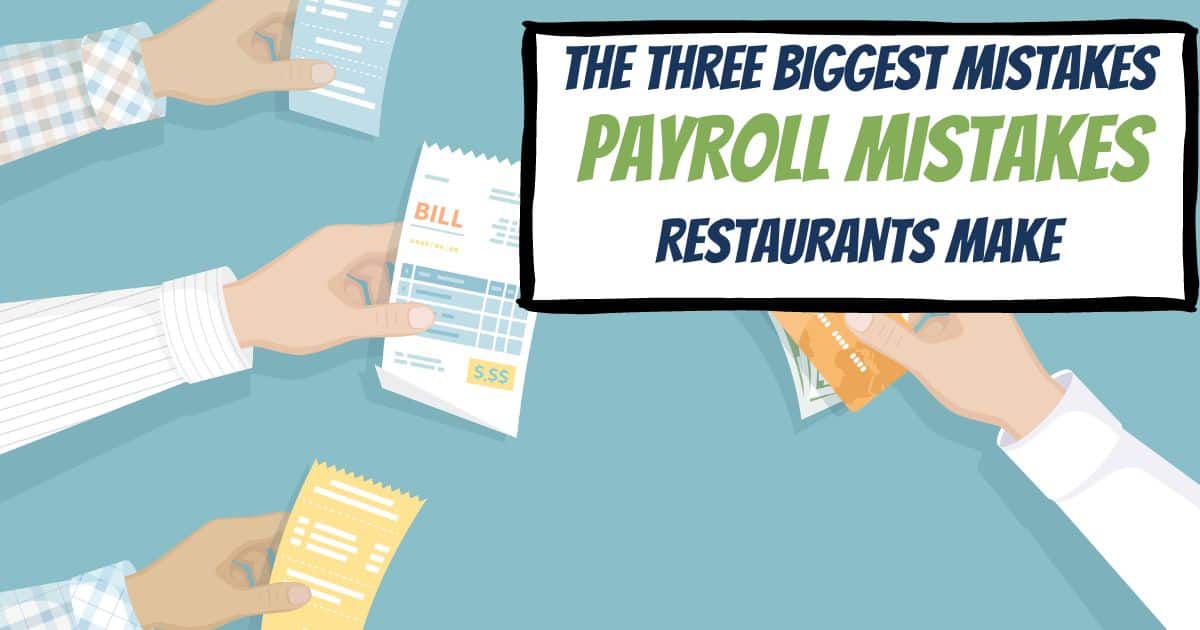The 3 Biggest Payroll Mistakes Restaurants Make
January 27th, 2025 | 3 min. read

Payroll might not be the first thing on your mind when you open your restaurant each day, but when mistakes happen, they can be disastrous for business. For a restaurant owner, getting audited by the Department of Labor is like something out of a horror story. Audits have taken down establishments that were profitable for decades.
The food service industry is a prime target for audits because many owners don’t realize they are making three major payroll mistakes. These mistakes can be summed up in a single sentence: You are not paying your employees correctly.
This can take many forms—issues with regular vs. tipped wages, improperly recording tips, or miscalculating overtime. Even if your employees are grossing the correct dollar amount, there are still ways to improve how you pay them and record their wages. Let’s start with the first common mistake:
1. Misunderstanding How Tipped Employees and Minimum Wage Work
The federal minimum wage is $7.25 per hour, and without exception, anyone legally employed in the U.S. must earn at least that amount. Regular wages are paid at $7.25 or higher. Tipped wages, however, follow a different structure—the federal minimum tipped wage is $2.13 per hour.
Tipped wages are not an exception to minimum wage laws. Every tipped employee must still earn at least $7.25 per hour after tips. Some states have higher minimum tipped wages, but the key distinction remains: tipped wages must meet or exceed the regular minimum wage once tips are factored in.
How Tipped Wages Work in Restaurants
One thing that sets the food service industry apart is the reliance on tipped workers. Customers have become so accustomed to tipping that even in fast-casual settings, skipping the tip can feel socially awkward.
Because of tipping culture, restaurant owners are allowed to pay employees an hourly rate of $2.13, assuming tips will bring their total hourly earnings above the federal or state minimum wage. If an employee’s tips do not make up the difference, the owner must compensate them for the shortfall.
Example of a Wage Shortfall
Let’s say Tony is a server earning the federal minimum tipped wage of $2.13 per hour. He works two five-hour weeknight shifts and earns $40 in tips.
- Tony’s total earnings: $21.30 (wages) + $40 (tips) = $61.30
- But the minimum amount he should earn for 10 hours of work is $72.50 ($7.25 × 10 hours)
- The owner must pay Tony an additional $11.20 to make up the difference.
Is Your Payroll System Catching This?
The good news: some payroll systems automatically make these calculations. The bad news: they only work if you input the data correctly. Many systems require specific earnings codes or designated fields for tracking hours. If you’re unsure whether your payroll system is calculating tipped wages accurately, don’t assume—it’s worth reaching out to your provider for confirmation.
2. Not Keeping Proper Tip Records
The second common mistake is failing to maintain accurate tip records. If you’re not tracking every cent your servers make in tips, you could be overpaying employees—or worse, underpaying them without proof to defend yourself in an audit.
Why Accurate Tip Records Matter
The Department of Labor puts the burden of proof on the employer. If your records aren’t airtight, they could create major problems for your business. Even if you’re paying employees correctly, a lack of proper documentation could make it appear as though you aren’t.
How to Track Tips Properly
Whether employees cash out each night or receive their tips on payday, your payroll system should be used to track tips accurately. If you use an outsourced payroll service, your provider should have a simple way to record tips, calculate taxes, and include them on W-2s.
3. Misunderstanding Overtime and Paying It Incorrectly
The third common mistake restaurant owners make is miscalculating overtime or failing to pay it at all. This is a particularly complex issue in the food service industry, where employees often work multiple roles or at multiple locations.
Example of a Complex Overtime Calculation
Let’s say Tony works:
- 6 hours in the kitchen at $10/hour
- 7 hours at the bar at $5.25/hour plus tips
- 12 hours as a manager on duty at $15/hour
- Two 10-hour shifts as a server at $2.13/hour plus tips
That’s 45 total hours in one week. But how should his overtime rate be calculated? If you get it wrong, you’re breaking the law.
Why This Matters: Back Wages Can Be a Backbreaker
Failing to pay the correct amount of overtime could mean owing back wages to all employees. On the other hand, overpaying could drain your restaurant’s cash flow.
The most generous overtime calculation in Tony’s case would be to pay his overtime hours at $22.50/hour. This would prevent any potential back wages in an audit, but if you apply this method to all employees, it could cost your business thousands in unnecessary payroll expenses.
In an industry where cash flow determines survival, getting overtime calculations wrong is not a sustainable option.
Payroll Mistakes Are Avoidable
We know you didn’t get into the restaurant business because you love dealing with payroll. These aren’t the secrets to making your restaurant massively successful—but they are the fundamentals that keep your business compliant and running smoothly.
If the big bad wolf ever comes knocking, you want to be confident that your payroll foundation is solid. Your payroll provider should be helping you stay on track and meet all restaurant-specific payroll requirements.
Unsure if you've got the support you need and want to explore other options? Check out How to Switch Payroll Services Smoothly to learn what to expect when changing providers.
Topics: